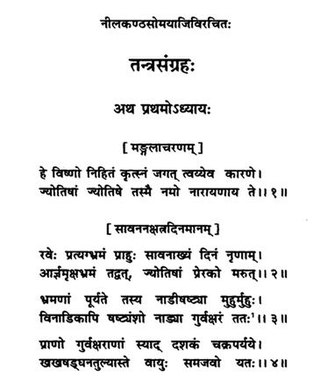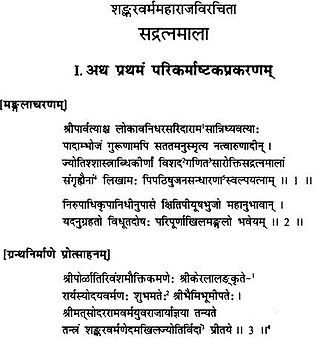Related Research Articles
Keļallur Nīlakaṇṭha Somayāji, also referred to as Keļallur Comatiri, was a major mathematician and astronomer of the Kerala school of astronomy and mathematics. One of his most influential works was the comprehensive astronomical treatise Tantrasamgraha completed in 1501. He had also composed an elaborate commentary on Aryabhatiya called the Aryabhatiya Bhasya. In this Bhasya, Nilakantha had discussed infinite series expansions of trigonometric functions and problems of algebra and spherical geometry. Grahapariksakrama is a manual on making observations in astronomy based on instruments of the time.
Vatasseri Parameshvara Nambudiri was a major Indian mathematician and astronomer of the Kerala school of astronomy and mathematics founded by Madhava of Sangamagrama. He was also an astrologer. Parameshvara was a proponent of observational astronomy in medieval India and he himself had made a series of eclipse observations to verify the accuracy of the computational methods then in use. Based on his eclipse observations, Parameshvara proposed several corrections to the astronomical parameters which had been in use since the times of Aryabhata. The computational scheme based on the revised set of parameters has come to be known as the Drgganita or Drig system. Parameshvara was also a prolific writer on matters relating to astronomy. At least 25 manuscripts have been identified as being authored by Parameshvara.
Mādhava of Sangamagrāma (Mādhavan) was an Indian mathematician and astronomer who is considered to be the founder of the Kerala school of astronomy and mathematics in the Late Middle Ages. Madhava made pioneering contributions to the study of infinite series, calculus, trigonometry, geometry and algebra. He was the first to use infinite series approximations for a range of trigonometric functions, which has been called the "decisive step onward from the finite procedures of ancient mathematics to treat their limit-passage to infinity".
Jyeṣṭhadeva was an astronomer-mathematician of the Kerala school of astronomy and mathematics founded by Madhava of Sangamagrama. He is best known as the author of Yuktibhāṣā, a commentary in Malayalam of Tantrasamgraha by Nilakantha Somayaji (1444–1544). In Yuktibhāṣā, Jyeṣṭhadeva had given complete proofs and rationale of the statements in Tantrasamgraha. This was unusual for traditional Indian mathematicians of the time. The Yuktibhāṣā is now believed to contain the essential elements of calculus like Taylor and infinity series. Jyeṣṭhadeva also authored Drk-karana, a treatise on astronomical observations.

The Kerala school of astronomy and mathematics or the Kerala school was a school of mathematics and astronomy founded by Madhava of Sangamagrama in Tirur, Malappuram, Kerala, India, which included among its members: Parameshvara, Neelakanta Somayaji, Jyeshtadeva, Achyuta Pisharati, Melpathur Narayana Bhattathiri and Achyuta Panikkar. The school flourished between the 14th and 16th centuries and its original discoveries seem to have ended with Narayana Bhattathiri (1559–1632). In attempting to solve astronomical problems, the Kerala school independently discovered a number of important mathematical concepts. Their most important results—series expansion for trigonometric functions—were described in Sanskrit verse in a book by Neelakanta called Tantrasangraha, and again in a commentary on this work, called Tantrasangraha-vakhya, of unknown authorship. The theorems were stated without proof, but proofs for the series for sine, cosine, and inverse tangent were provided a century later in the work Yuktibhasa, written in Malayalam, by Jyesthadeva, and also in a commentary on Tantrasangraha.

Yuktibhāṣā, also known as Gaṇita-yukti-bhāṣā and Gaṇitanyāyasaṅgraha, is a major treatise on mathematics and astronomy, written by the Indian astronomer Jyesthadeva of the Kerala school of mathematics around 1530. The treatise, written in Malayalam, is a consolidation of the discoveries by Madhava of Sangamagrama, Nilakantha Somayaji, Parameshvara, Jyeshtadeva, Achyuta Pisharati, and other astronomer-mathematicians of the Kerala school. It also exists in a Sanskrit version, with unclear author and date, composed as a rough translation of the Malayalam original.

Tantrasamgraha, or Tantrasangraha, is an important astronomical treatise written by Nilakantha Somayaji, an astronomer/mathematician belonging to the Kerala school of astronomy and mathematics. The treatise was completed in 1501 CE. It consists of 432 verses in Sanskrit divided into eight chapters. Tantrasamgraha had spawned a few commentaries: Tantrasamgraha-vyakhya of anonymous authorship and Yuktibhāṣā authored by Jyeshtadeva in about 1550 CE. Tantrasangraha, together with its commentaries, bring forth the depths of the mathematical accomplishments the Kerala school of astronomy and mathematics, in particular the achievements of the remarkable mathematician of the school Sangamagrama Madhava. In his Tantrasangraha, Nilakantha revised Aryabhata's model for the planets Mercury and Venus. According to George G Joseph his equation of the centre for these planets remained the most accurate until the time of Johannes Kepler in the 17th century.
Govindasvāmi was an Indian mathematical astronomer most famous for his Bhashya, a commentary on the Mahābhāskarīya of Bhāskara I, written around 830. The commentary contains many examples illustrating the use of a Sanskrit place-value system and the construction of a sine table.

Sadratnamala is an astronomical-mathematical treatise in Sanskrit written by Sankara Varman, an astronomer-mathematician of the Kerala school of mathematics, in 1819. Even though the book has been written at a time when western mathematics and astronomy had been introduced in India, it is composed purely in the traditional style followed by the mathematicians of the Kerala school. Sankara Varman has also written a detailed commentary on the book in Malayalam.
Sankara Variyar was an astronomer-mathematician of the Kerala school of astronomy and mathematics. His family were employed as temple-assistants in the temple at Tṛkkuṭaveli near modern Ottapalam.
Haridatta was an astronomer-mathematician of Kerala, India, who is believed to be the promulgator of the Parahita system of astronomical computations. This system of computations is widely popular in Kerala and Tamil Nadu. According to legends, Haridatta promulgated the Parahita system on the occasion of the Mamankam held in the year 683 CE. Mamankam was a 12-yearly festival held in Thirunnavaya on the banks of the Bharathapuzha river.
In astronomy, Jyotirmimamsa is a treatise on the methodology of astronomical studies authored by Nilakantha Somayaji (1444–1544) in around 1504 CE. Nilakantha somayaji was an important astronomer-mathematician of the Kerala school of astronomy and mathematics and was the author of the much celebrated astronomical work titled Tantrasamgraha. This book stresses the necessity and importance of astronomical observations to obtain correct parameters for computations and to develop more and more accurate theories. It even discounts the role of revealed wisdom and divine intuitions in studying astronomical phenomena. Jyotirmimamsa is sometimes cited as proof to establish that modern methodologies of scientific investigations were known to ancient and medieval Indians. Neelkantha Somayaji insisted that computational results should tally with that of observations and astronomical parameters and constants should be revised periodically. To come to more precise conclusions, Neelkantha Somayaji have discussions with the astronomer and mathematicians of other schools.
Veṇvāroha is a work in Sanskrit composed by Mādhava of Sangamagrāma, the founder of the Kerala school of astronomy and mathematics. It is a work in 74 verses describing methods for the computation of the true positions of the Moon at intervals of about half an hour for various days in an anomalistic cycle. This work is an elaboration of an earlier and shorter work of Mādhava himself titled Sphutacandrāpti. Veṇvāroha is the most popular astronomical work of Mādhava.
Govinda Bhaṭṭathiri was an Indian astrologer and astronomer who flourished in Kerala during the thirteenth century CE.

T. A. Sarasvati Amma was a scholar born in Cherpulassery, Palakkad District, Kerala, India. She has contributed to the fields of history of Mathematics and Sanskrit, through her work on Geometry of ancient and medieval India.
Kriyakramakari (Kriyā-kramakarī) is an elaborate commentary in Sanskrit written by Sankara Variar and Narayana, two astronomer-mathematicians belonging to the Kerala school of astronomy and mathematics, on Bhaskara II's well-known textbook on mathematics Lilavati. Kriyakramakari, along with Yuktibhasa of Jyeshthadeva, is one of the main sources of information about the work and contributions of Sangamagrama Madhava, the founder of Kerala school of astronomy and mathematics. Also the quotations given in this treatise throw much light on the contributions of several mathematicians and astronomers who had flourished in an earlier era. There are several quotations ascribed to Govindasvami a 9th-century astronomer from Kerala.

A History of the Kerala School of Hindu Astronomy (in perspective) is the first definitive book giving a comprehensive description of the contribution of Kerala to astronomy and mathematics. The book was authored by K. V. Sarma who was a Reader in Sanskrit at Vishveshvaranand Institute of Sanskrit and Indological Studies, Panjab University, Hoshiarpur, at the time of publication of the book (1972). The book, among other things, contains details of the lives and works of about 80 astronomers and mathematicians belonging to the Kerala School. It has also identified 752 works belonging to the Kerala school.
Mazhamaṅgalaṃ Śaṅkaran Naṃpūtiri (1494-1570) was an Indian astronomer-astrologer-mathematician belonging to the Kerala school of astronomy and mathematics who wrote a large number of books on astronomy and astrology in the vernacular language Malayalam in an effort to popularize these subjects among the common Malayalam speaking laypersons. He hailed from Peruvanam village in present-day Thrissur district. He spent most of his active life at Chengannur with his teacher Parameśvaran Pōtti of Vāzha-māveli house.
Thrikkandiyoor is a village in Tirur Block in Malappuram district of Kerala state in India. The village is known for a Shiva Temple located at the heart of the village. Devotees of Shiva believe that the idol in the temple was installed by Parashurama, the
Devācārya was an Indian astronomer hailing from Kerala, India who flourished during the second half of 7th century CE. He is the author of a karaņa text on astronomy titled Karaņaratna which deals with almost every aspect of planetary astronomy generally discussed in other Indian texts on astronomy. This work is important in the study of history of astronomy in India as it sheds valuable light on the methods used by the astronomers of South India, in the seventh century CE, in their astronomical computations. No personal information about Devācārya is known except that his father's name was Gojanma and that Devācārya was a great devotee of Viṣṇu, Ŝiva and Brahma. That he flourished during the second half of the seventh century CE is inferred from the fact the epoch specified in Karaņaratna is the first day of the year 611 Saka Era which corresponds to 26 February 689 CE.
References
- ↑ J J O'Connor and E F Robertson (November 2000). "Paramesvara". School of Mathematics and Statistics, University of St Andrews, Scotland. Retrieved 27 January 2010.
- ↑ K.V. Sarma. "Tantrsamgraha with translation" (PDF). Indian Journal of History of Science. Archived from the original (PDF) on 9 March 2012.